“This post contains affiliate links, and I will be compensated if you make a purchase after clicking on my links.”
Spring has most definitely sprung, and so has the allergy season. For most, the spring season is beautiful, but for allergy sufferers? Not so much!
And like us hoomans, our four-legged best friends can suffer from spring allergies, too. So, continue reading to learn more about seasonal allergies in dogs during spring so you can help your dog enjoy the season without an itchy and irritated skin.

What Are Spring Seasonal Allergies in Dogs?
Similar to us hoomans, our dogs also experience different allergies at different times of the year and depending on the triggers.
Seasonal allergies don’t only happen during spring, it can also happen during other seasons, like the summer season. But for most, both humans and dogs alike, spring is the most challenging time of the year.
This is because as trees and flowers bloom during spring, they release pollen in the air. Not only trees and flowers, but shrubs and even grasses release pollen during spring. And these pollens are very common spring allergens that can trigger seasonal allergies in dogs.
When Are Dogs Most Likely To Get Spring Seasonal Allergies?
Common Spring Allergens For Dogs
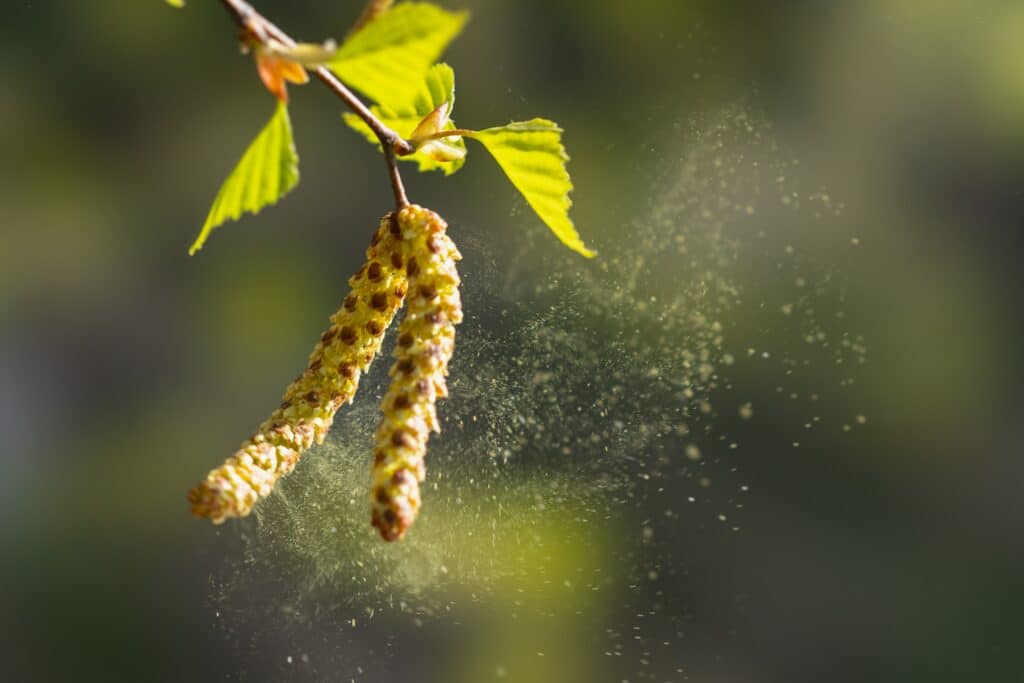
Spring seasonal allergies in dogs are triggered by different allergens that are common during spring. Your dog can inhale these allergens or they can get trapped in your pooch’s fur.
Here are common spring allergens for dogs:
- Tree pollen (cedar, ash, oak)
- Grass pollen
- Weed pollen
- Fleas
- Ticks
- Stinging insects (bees and wasps)
- Mold spores
- Dust mites
Spring Seasonal Allergies Symptoms To Look Out For
Hoomans and dogs with spring allergies suffer the same problem but do not suffer the same way. This is because when humans suffer spring allergies, they usually have a runny nose and itchy eyes. But for dogs, their skin is usually the target.
Here are spring season allergy symptoms in dogs that you should look out for:
1. Red, Inflamed, Or Irritated Skin
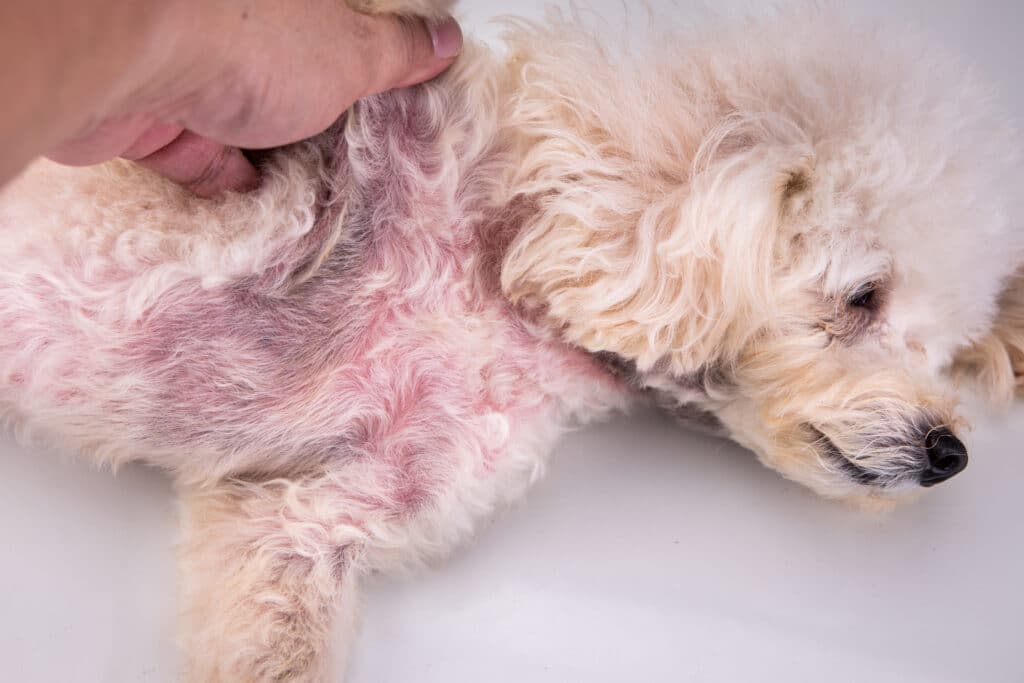
As mentioned above, when dogs suffer from seasonal allergies, their skin suffer the most. So, dogs that have spring season allergies usually have red, inflamed, or infected skin. And when this happens, a domino effect happens as other allergy symptoms start showing.
2. Scratching
This is probably the easiest way to tell if your dog has spring season allergies. Due to their skin being inflamed, your dog will start scratching and/or biting their skin or coat more than usual while outdoors or right after coming indoors.
They may also start scratching or rubbing their face on surfaces due to itchiness.
3. Excessive Licking
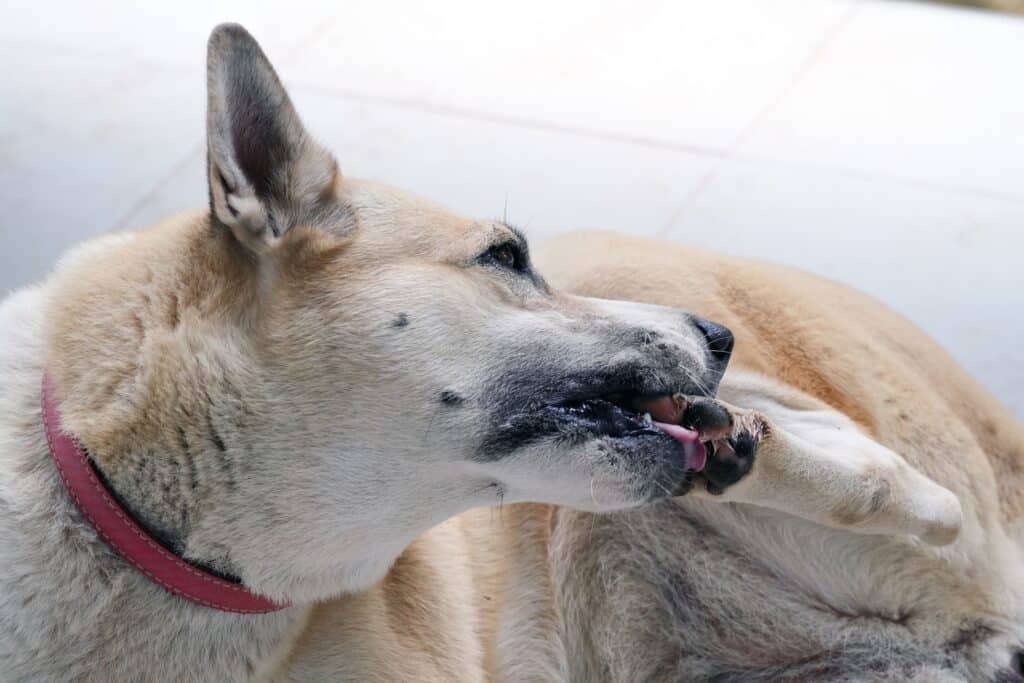
When your dog has an allergic reaction, they will start to excessively lick some parts of their body that they can’t scratch. You’ll notice that they’ll start excessively licking body parts such as their paws and their anal glands.
4. Shedding And Hair Loss
As the allergic reaction progresses, a dog’s hair follicles get affected as well. You’ll notice that your dog will start excessively shedding and losing hair.
Any area of the body can be affected by this. But usually, this can often be seen on the belly, legs, and the tail area.
5. Red, Waxy, Or Inflamed Ears
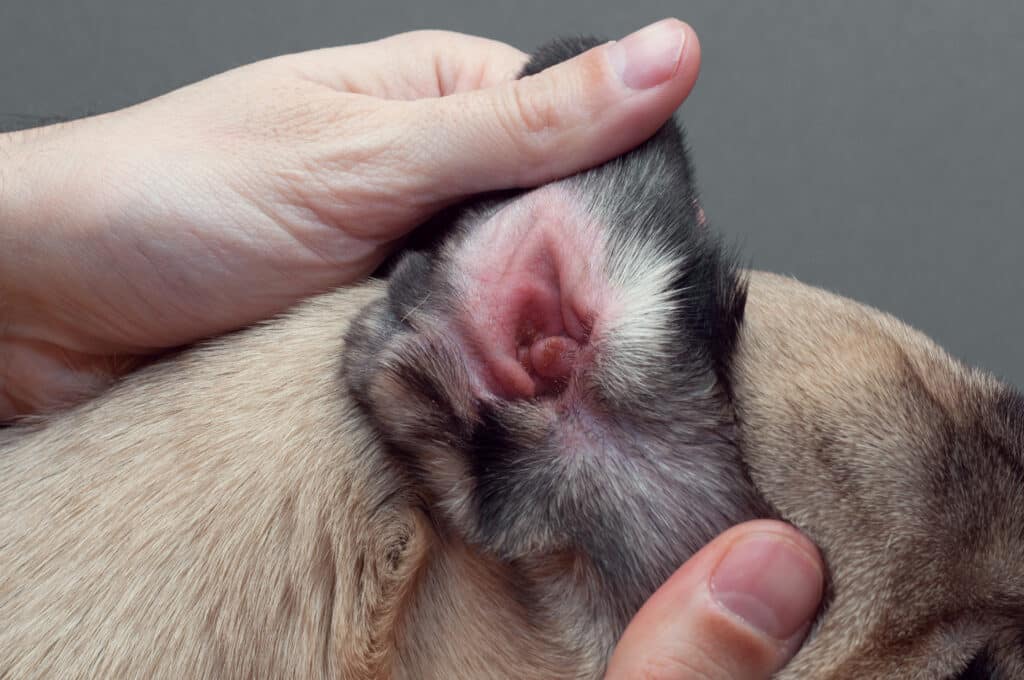
Spring seasonal allergies in dogs doesn’t only affect a dog’s skin, it can also affect the ears. A dog’s ears can become red, itchy and irritated and this can then lead to waxy and infected ears.
If you notice that your dog shakes their head more than usual, check their ears for any irritation or discomfort.
6. Sneezing more than usual
Sneezing is another sign of an allergic reaction. If you see your dog sneezing more than usual, then it must be the allergies acting up.
Aside from the typical sneezing, reverse sneezing is another symptom you should look out for!
7. Skin Discoloration
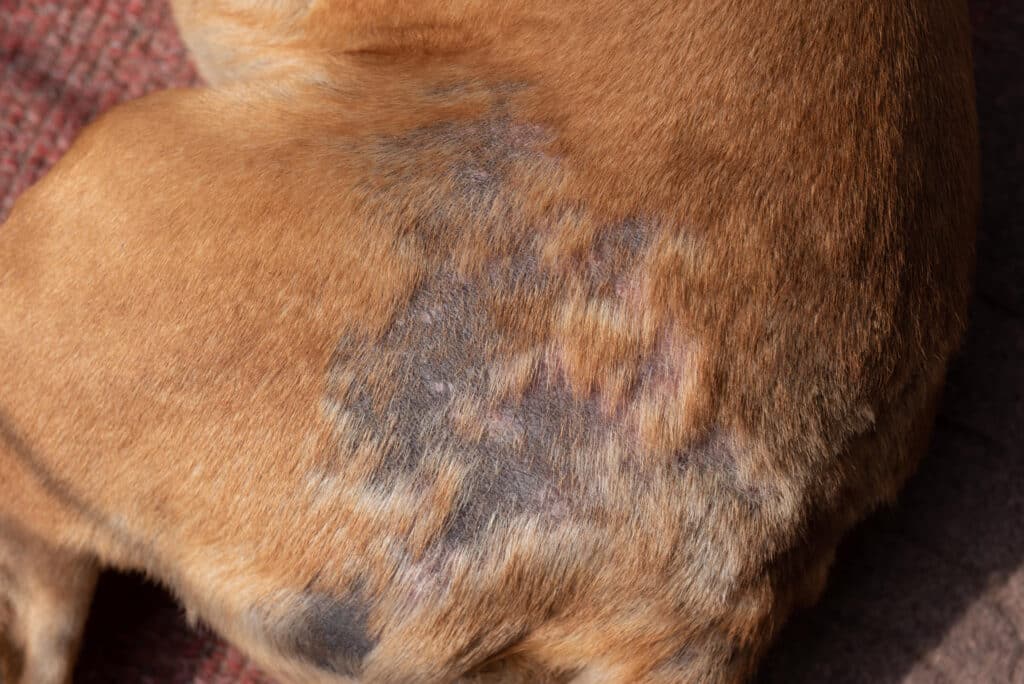
Due to allergies, your dog’s skin may turn unusually dark. The skin discoloration usually happens due to other allergy symptoms. Due to excessive scratching, the skin can get damaged and it can disrupt the skin’s pigmentation, resulting to an unusually dark discoloration.
Most Commonly Affected Areas Of Spring Season Allergies
Along with the above mentioned symptoms, remember the most commonly affected areas of seasonal allergies in dogs so you can easily take action. These areas are:
- Ears
- Paws
- Toes
- Underarms
- Groin
- Muzzle
How Do Veterinarians Diagnose Seasonal Allergies In Dogs?
Your vet may also recommend that you take your dog to a veterinary dermatologist for an in-depth skin testing. This test is another accurate method of diagnosing seasonal allergies in dogs.
5 Ways To Manage Spring Seasonal Allergies in Dogs
Sadly, there is no permanent cure for seasonal allergies in dogs. However, that doesn’t mean your dog has to suffer throughout the season.
There are still ways to manage symptoms and help your pooch feel comfortable, including:
1. Avoid Allergens
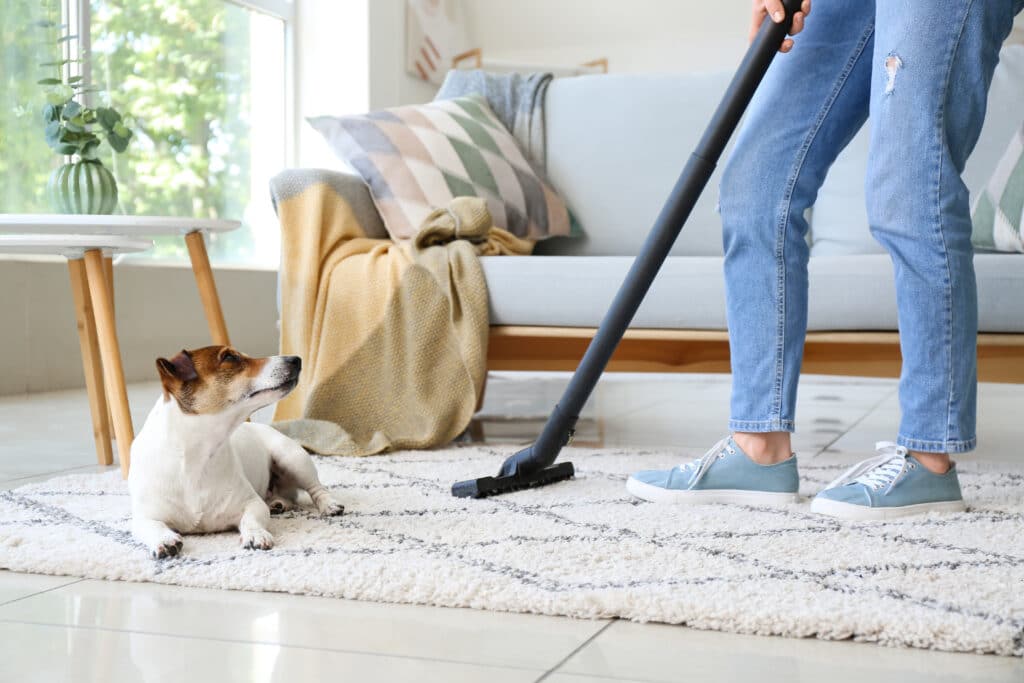
The best way to relieve your dog from its allergy symptoms is by avoiding what triggers their allergies. This might sound easy, but can actually be tough since you just can’t keep your dogs indoors throughout spring and pollen and other allergens are airborne.
However, you can still limit allergen exposure with the following tips:
- Alter your daily walk routine. Avoid walking your dog in the early morning or late afternoon when pollen levels are usually the highest.
- After walking your dog, clean their body and paws with a moist cloth or hypoallergenic wipes to get rid of any pollen that may have stuck to their coat and paws while they were outdoors.
- Wash your dog’s bedding and plush toys weekly in hot, soapy water and make sure to dry completely to kill dust mites.
- Vacuum soft surfaces, such as the sofa or carpets, more often.
- Use dehumidifiers to prevent mold growth in kitchens, bathrooms, and other areas that can accumulate moisture.
2. Bathing And Grooming
Bathing your dog with hypoallergenic shampoo that are specifically formulated for skin irritations and allergic reactions will help reduce the symptoms. And frequent bathing will also help remove the allergens that get trapped in your dog’s fur and skin.
You can choose from these hypoallergenic shampoo recommendations:
Aside from bathing, keeping their ears and paws clean will also help reduce allergy symptoms and overall discomfort.
You can help relieve itchiness, reduce inflammation and soothe your dog’s discomfort with the following recommendations:
3. Flea And Tick Prevention
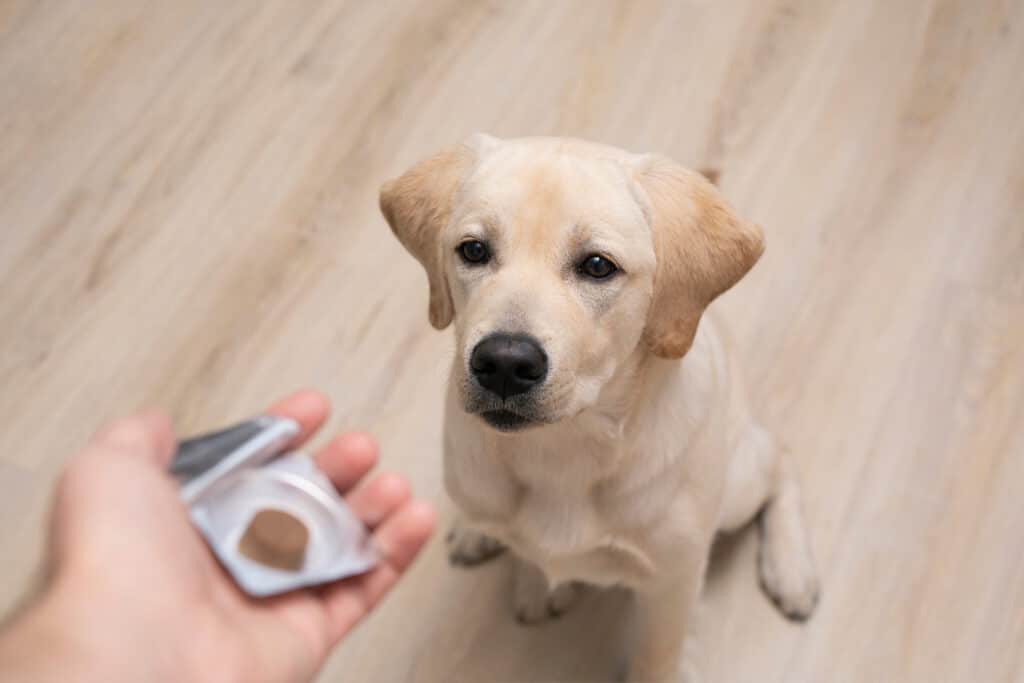
Since fleas and ticks are common spring allergens, your veterinarian may recommend using year-round flea and tick prevention medication such as NexGard®, Simparica®, Bravecto®, Seresto® collar, and K9 Advantix™ II.
4. Supplements
Supplements such as fish oil supplements are another way to relieve allergy symptoms in dogs. Omega-3 fatty acid helps protect a dog’s skin barrier and can specifically help with excessive anal gland licking, therefore minimizing allergy symptoms.
However, it takes four to six weeks for fish oil supplement to take effect, so it’s best to put your dog on these supplements all year.
5. Oral Medication

Depending on how severe the allergy symptoms are and what area of the body is affected, your dog’s vet will prescribe oral medication to tackle the problem at hand.
Please make sure to talk to your dog’s vet before using any medication. Some require prescriptions and have side effects that can affect your dog’s overall health.
6. Immunotherapy
Immunotherapy in the form of allergy shots or allergy oral drops are formulated based on a dog’s allergy test results. So, this means your dog must be allergy tested by a veterinary dermatologist to determine which allergens cause the reaction.
The way this works is that the dog is introduced small amounts of what they’re allergic to and then gradually increasing the dose over time, until the dog’s immune system builds a tolerance to the allergens.
This form of treatment is a great choice for dogs who have not responded well to other treatment methods. Furthermore, this works better for younger dogs. So, you might want to consider this option if all else fails.
Final Thoughts
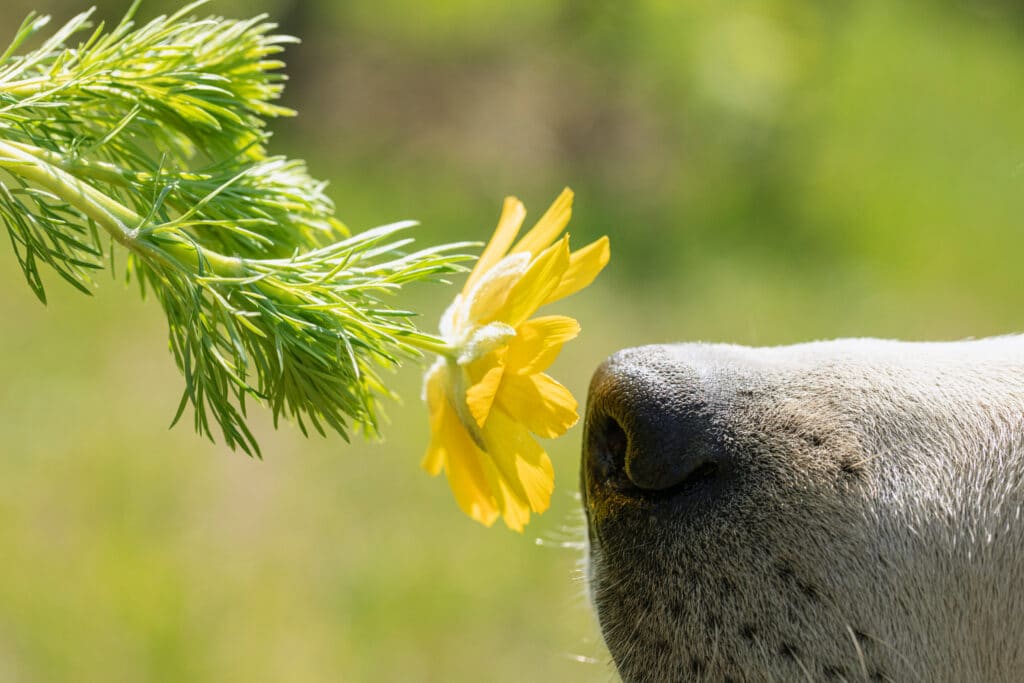
While there are no cure for seasonal allergies in dogs, many treatment options are available to help our dogs feel more comfortable.
Especially because we, hoomans, know how difficult and uncomfortable it is to suffer from and deal with seasonal allergies in spring first hand. So, of course we should do the same for our dogs and help address the problem.
And the sooner we do it, the better. Because we can help control the symptoms and prevent the condition from worsening.

























